Unit 2 What time do you go to school?教学案
文档属性
| 名称 | Unit 2 What time do you go to school?教学案 | 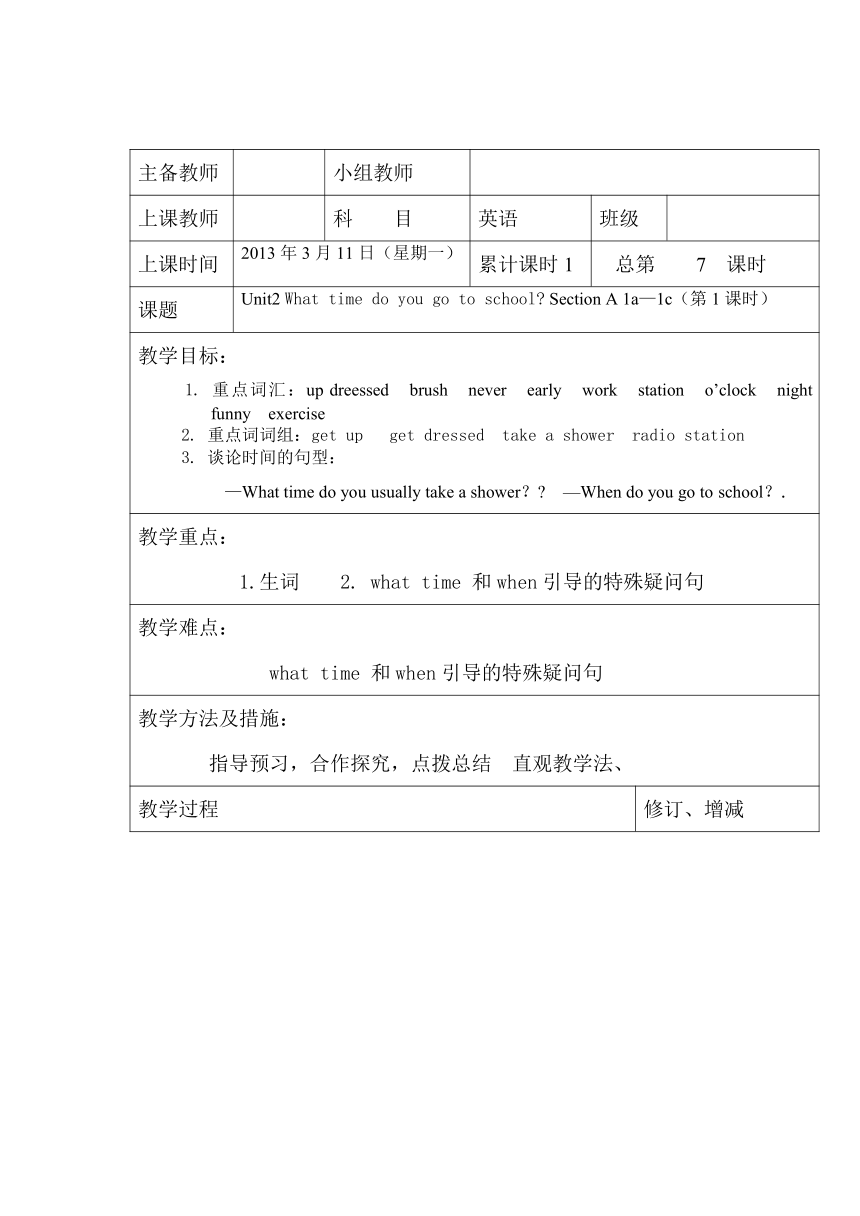 | |
| 格式 | zip | ||
| 文件大小 | 34.6KB | ||
| 资源类型 | 教案 | ||
| 版本资源 | 人教新目标(Go for it)版 | ||
| 科目 | 英语 | ||
| 更新时间 | 2014-02-15 15:52:21 | ||
图片预览

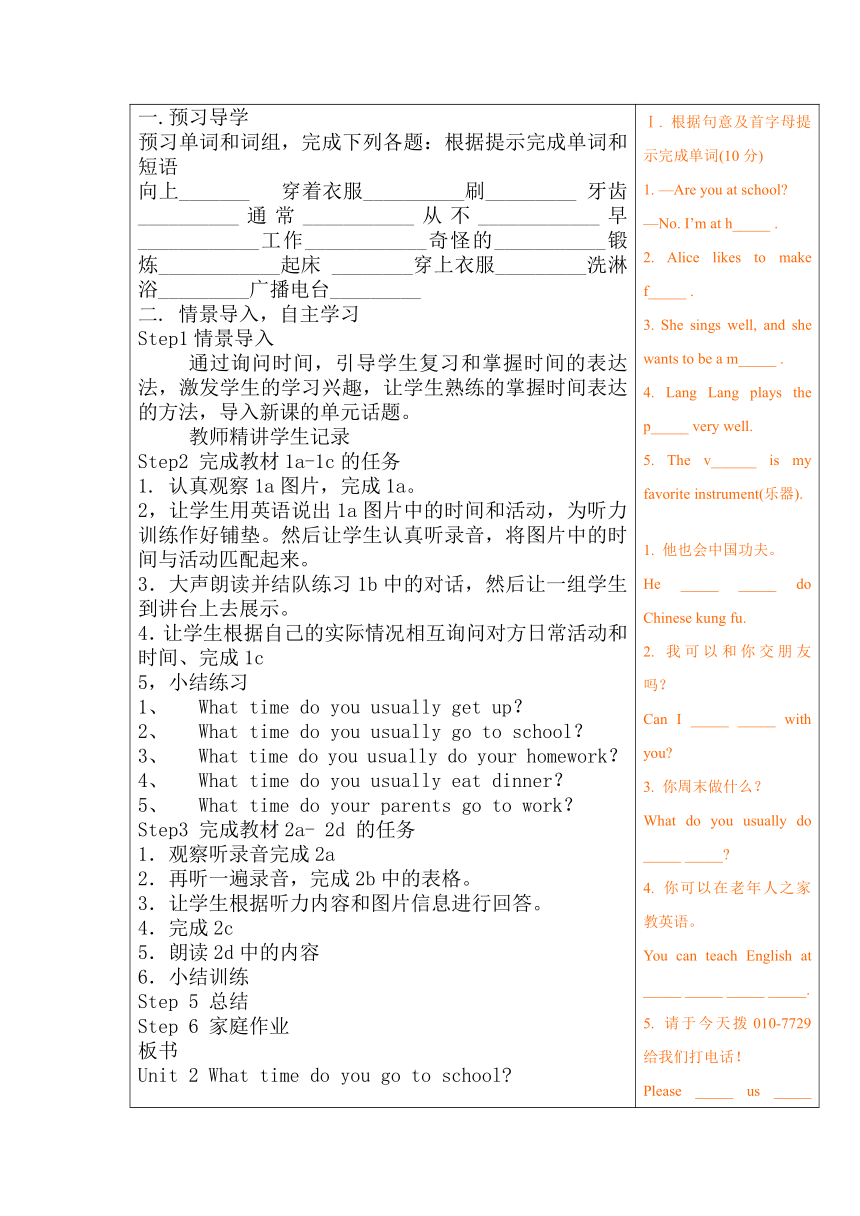
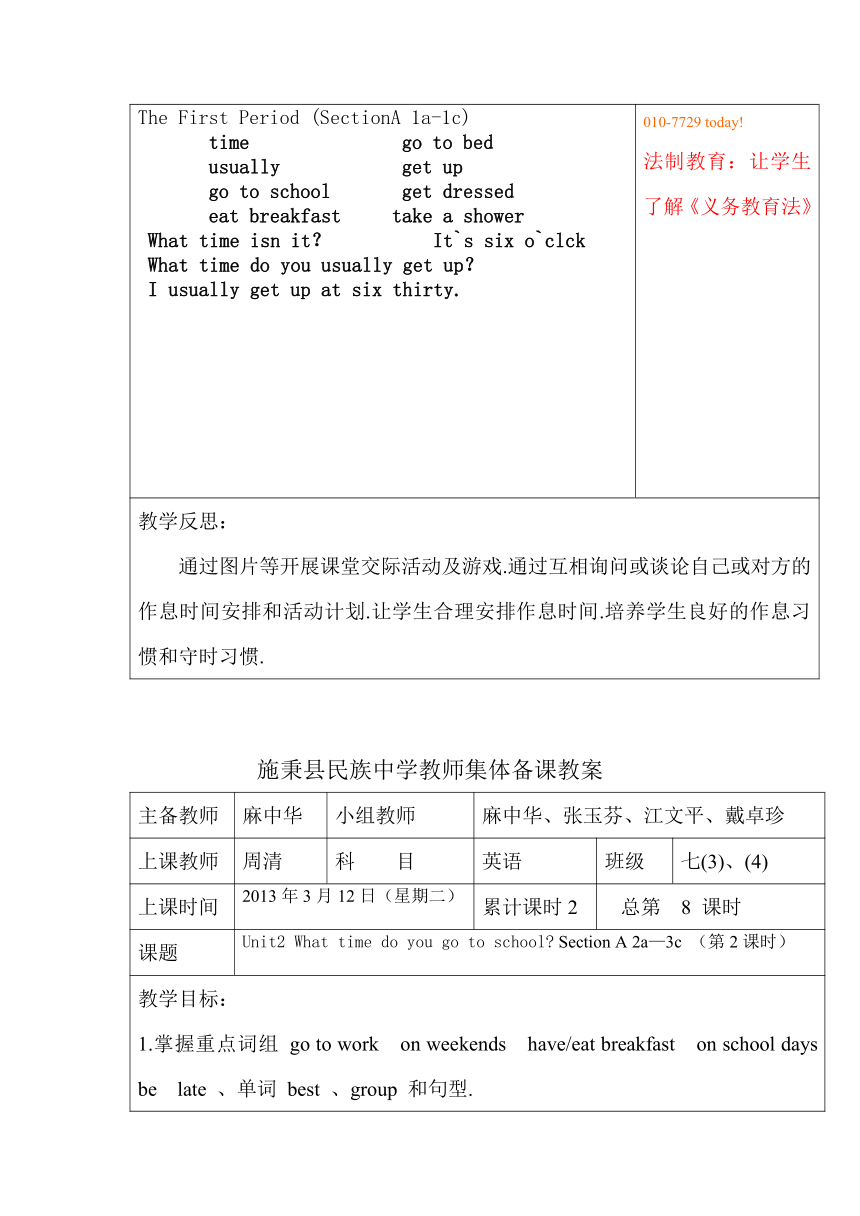
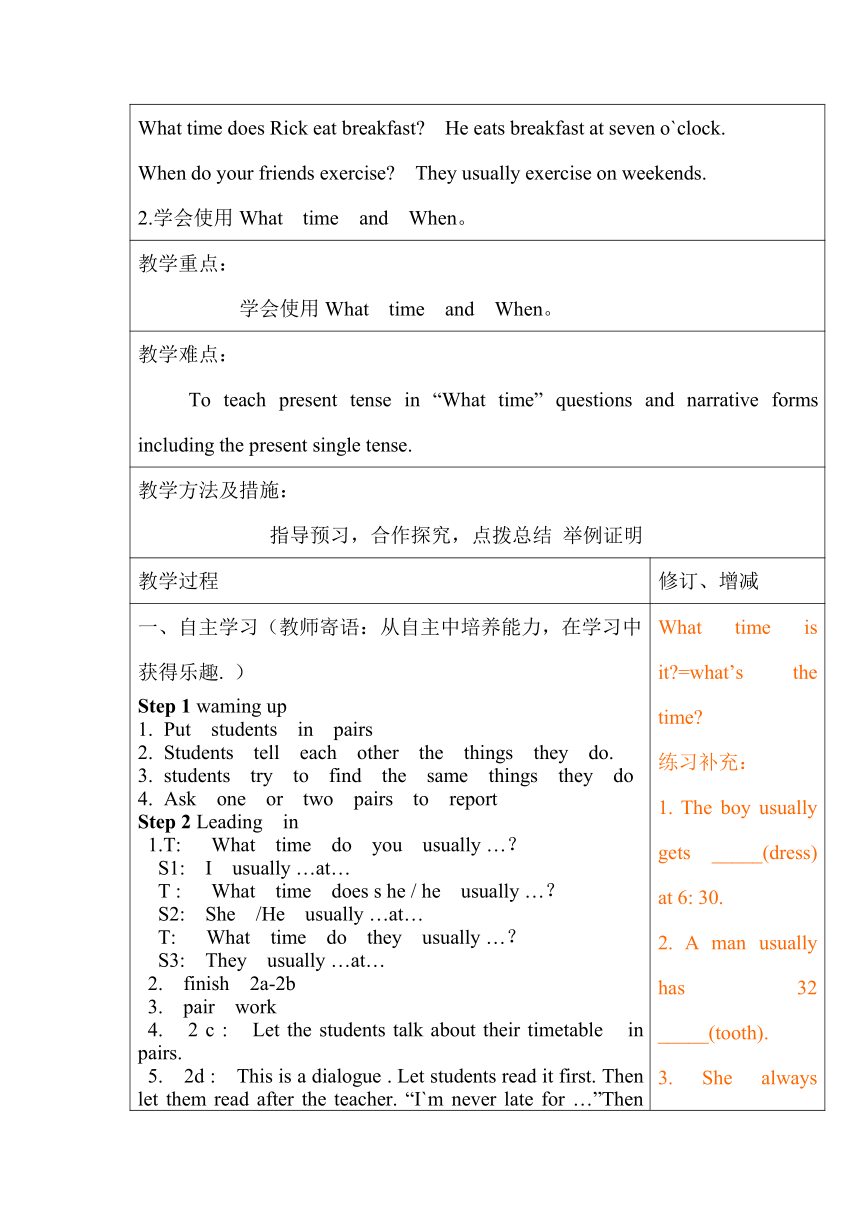
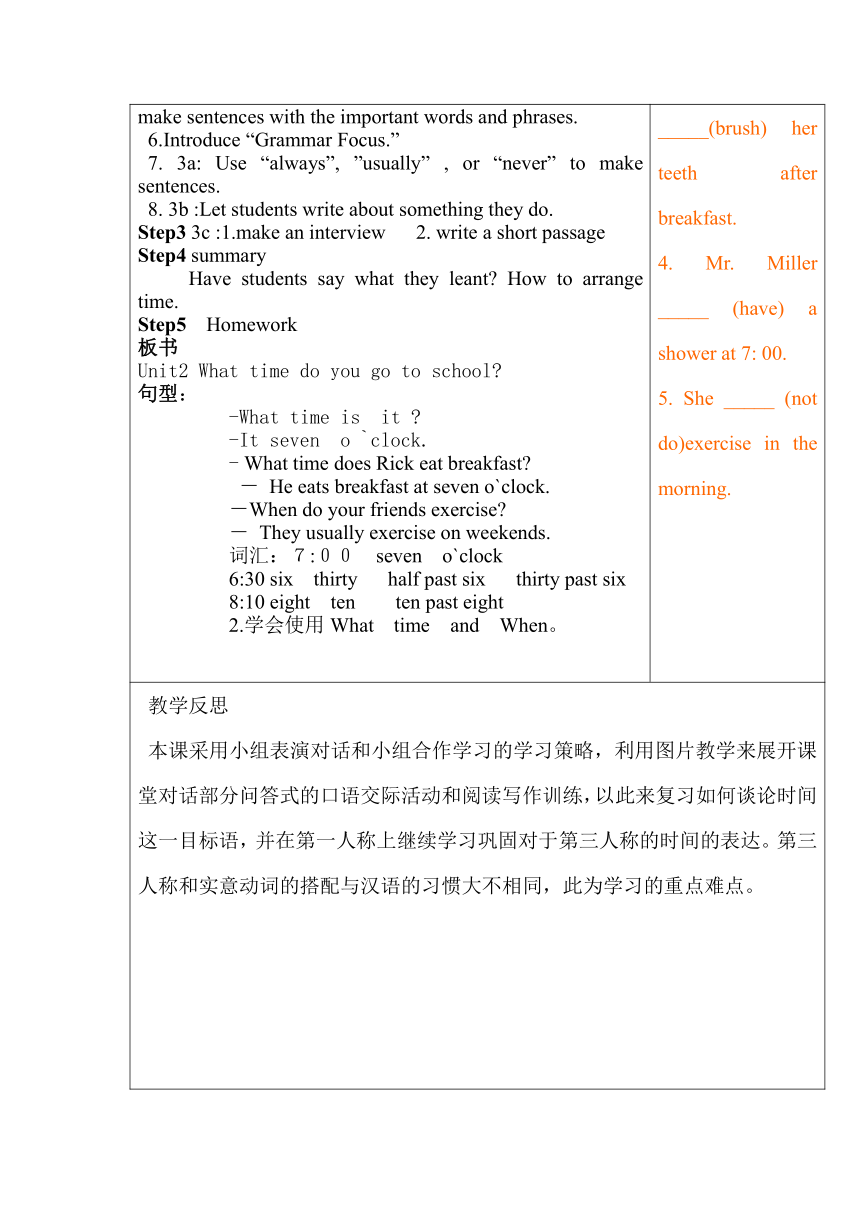
文档简介
主备教师 小组教师
上课教师 科 目 英语 班级
上课时间 2013年3月11日(星期一) 累计课时1 总第 7 课时
课题 Unit2 What time do you go to school Section A 1a—1c(第1课时)
教学目标:1. 重点词汇:up dreessed brush never early work station o’clock night funny exercise 2. 重点词词组:get up get dressed take a shower radio station 3. 谈论时间的句型:—What time do you usually take a shower? —When do you go to school?.
教学重点:1.生词 2. what time 和when引导的特殊疑问句
教学难点:what time 和when引导的特殊疑问句
教学方法及措施: 指导预习,合作探究,点拨总结 直观教学法、
教学过程 修订、增减
一.预习导学预习单词和词组,完成下列各题:根据提示完成单词和短语向上_______ 穿着衣服__________刷_________ 牙齿__________通常___________从不____________早 ____________工作____________奇怪的___________锻炼____________起床 ________穿上衣服_________洗淋浴_________广播电台_________二. 情景导入,自主学习Step1情景导入 通过询问时间,引导学生复习和掌握时间的表达法,激发学生的学习兴趣,让学生熟练的掌握时间表达的方法,导入新课的单元话题。 教师精讲学生记录Step2 完成教材1a-1c的任务1. 认真观察1a图片,完成1a。2,让学生用英语说出1a图片中的时间和活动,为听力训练作好铺垫。然后让学生认真听录音,将图片中的时间与活动匹配起来。3.大声朗读并结队练习1b中的对话,然后让一组学生到讲台上去展示。4.让学生根据自己的实际情况相互询问对方日常活动和时间、完成1c5,小结练习What time do you usually get up?What time do you usually go to school?What time do you usually do your homework?What time do you usually eat dinner?What time do your parents go to work?Step3 完成教材2a- 2d 的任务1.观察听录音完成2a2.再听一遍录音,完成2b中的表格。3.让学生根据听力内容和图片信息进行回答。4.完成2c5.朗读2d中的内容6.小结训练Step 5 总结Step 6 家庭作业板书Unit 2 What time do you go to school The First Period (SectionA 1a-1c)time go to bed usually get up go to school get dressed eat breakfast take a shower What time isn it? It`s six o`clckWhat time do you usually get up?I usually get up at six thirty. Ⅰ. 根据句意及首字母提示完成单词(10分)1. —Are you at school —No. I’m at h_____ . 2. Alice likes to make f_____ . 3. She sings well, and she wants to be a m_____ . 4. Lang Lang plays the p_____ very well. 5. The v______ is my favorite instrument(乐器). 1. 他也会中国功夫。He _____ _____ do Chinese kung fu. 2. 我可以和你交朋友吗?Can I _____ _____ with you 3. 你周末做什么?What do you usually do _____ _____ 4. 你可以在老年人之家教英语。You can teach English at _____ _____ _____ _____. 5. 请于今天拨010-7729给我们打电话!Please _____ us _____ 010-7729 today! 法制教育:让学生了解《义务教育法》
教学反思: 通过图片等开展课堂交际活动及游戏.通过互相询问或谈论自己或对方的作息时间安排和活动计划.让学生合理安排作息时间.培养学生良好的作息习惯和守时习惯.
施秉县民族中学教师集体备课教案
主备教师 麻中华 小组教师 麻中华、张玉芬、江文平、戴卓珍
上课教师 周清 科 目 英语 班级 七(3)、(4)
上课时间 2013年3月12日(星期二) 累计课时2 总第 8 课时
课题 Unit2 What time do you go to school Section A 2a—3c (第2课时)
教学目标:1.掌握重点词组 go to work on weekends have/eat breakfast on school days be late 、单词 best 、group 和句型.What time does Rick eat breakfast He eats breakfast at seven o`clock. When do your friends exercise They usually exercise on weekends.2.学会使用What time and When。
教学重点:学会使用What time and When。
教学难点:To teach present tense in “What time” questions and narrative forms including the present single tense.
教学方法及措施: 指导预习,合作探究,点拨总结 举例证明
教学过程 修订、增减
一、自主学习(教师寄语:从自主中培养能力,在学习中获得乐趣. )Step 1 waming up Put students in pairsStudents tell each other the things they do.students try to find the same things they do Ask one or two pairs to reportStep 2 Leading in1.T: What time do you usually …?S1: I usually …at…T : What time does s he / he usually …?S2: She /He usually …at…T: What time do they usually …?S3: They usually …at…2. finish 2a-2b3. pair work 4. 2 c : Let the students talk about their timetable in pairs.5. 2d : This is a dialogue . Let students read it first. Then let them read after the teacher. “I`m never late for …”Then make sentences with the important words and phrases.6.Introduce “Grammar Focus.”7. 3a: Use “always”, ”usually” , or “never” to make sentences.8. 3b :Let students write about something they do.Step3 3c :1.make an interview 2. write a short passageStep4 summary Have students say what they leant How to arrange time.Step5 Homework板书Unit2 What time do you go to school 句型:-What time is it -It seven o `clock.- What time does Rick eat breakfast - He eats breakfast at seven o`clock. -When do your friends exercise - They usually exercise on weekends.词汇:7:00 seven o`clock6:30 six thirty half past six thirty past six8:10 eight ten ten past eight 2.学会使用What time and When。 What time is it =what’s the time 练习补充:1. The boy usually gets _____(dress) at 6: 30. 2. A man usually has 32 _____(tooth). 3. She always _____(brush) her teeth after breakfast. 4. Mr. Miller _____ (have) a shower at 7: 00. 5. She _____ (not do)exercise in the morning.
教学反思本课采用小组表演对话和小组合作学习的学习策略,利用图片教学来展开课堂对话部分问答式的口语交际活动和阅读写作训练,以此来复习如何谈论时间这一目标语,并在第一人称上继续学习巩固对于第三人称的时间的表达。第三人称和实意动词的搭配与汉语的习惯大不相同,此为学习的重点难点。
施秉县民族中学教师集体备课教案
主备教师 麻中华 小组教师 麻中华、张玉芬、江文平、戴卓珍
上课教师 周清 科 目 英语 班级 七(3)、(4)
上课时间 2013年3月13日(星期三) 累计课时3 总第 9 课时
课题 Unit2 What time do you go to school Section b 1a—3c (第3课时)
教学目标:Master the new words and useful expressions.
教学重点:How to use the important contents.
教学难点:时间表达法及对时间的提问。
教学方法及措施: 情景表现 讨论合作 精讲多练
教学过程 修订、增减
新词自查:根据首字母或汉语提示完成句子。1、I usually eat dinner at a quarter past six in the evening。2、The room is so dirty(脏的)!Let’s clean it now。3、My grandfather often takes a walk after dinner。4、My brother usually runs in the park every morning。5、Tom,don’t watch TV!It’s 10:00.It’s time to go to bed(上床睡觉)。6、They do their homework(做家庭作业)in the evening everyday。课堂导学方案Step 1 情景导入Teacher:When do you usually get up/take a shower/eat breakfast/go to school/have classes/eat lunch/go home/do homework/got bed…?Students:I usually…at…Teacher:When does he/she usually get up/take a shower/eat breakfast/go to school/have classes/eat lunch/go home/do homework/go to bed… Students:He/She usually…at…Step 2 完成教材1a-1e的任务操作案例1、让学生结合生活实际,将图片中的日常活动与相应的时间连接起来,完成教材1a的任务。(1分钟)Teacher:We often do different things at different time. Let’s look at la and match them.2、通过师生和学生之间的对话,完成1b的任务。(1分钟)Teacher:Please check the answers with another student. Do you usually do homework Students:Yes.Teacher:And when do you usually do your homework Please tell me.Students:I usually…3、听录音,让学生圈出所听到的相关活动,完成1c的任务。(3分钟)听力训练前,可先让学生朗读并掌握1c的词组,为听力训练作好铺垫。4、再听一篇录音,完成1d的任务。(1分钟)在听力训练前,先复习时间的表达法,并对学生进行听力技巧指导;听力训练后,可让学生根据听力材料的内容向全班同学做一个汇报。如:Tom gets up at half past five. He runs at…(这样可以培养学生的口头表达能力和写作能力)。5、对听力材料的重点词组或句子进行讲解,然后让全班学生分角色朗读并熟读听力材料,还可让若干组学生进行分角色朗读表演。(3分钟)Teacher:Now let’s listen to the tape and repeat. Please try to read like the tape.6、让学生根据1c中的作息时间表,分组谈话Tom的日常生活,并请若干组学生到讲台前表演对话,老师可以就学生对话的内容进行现场提问,完成1e的任务。A、When does Tom usually get up B、He usually gets up at half past five.A、When does Tom usually…?B、He usually…at…7、小结训练。(4分钟)书面表达。假如你是赛琳娜(Selina),你的笔友肯(Ken)来信询问你周末是怎样度过的,请根据下面的表格并适当发挥,写一篇不少于50词的短文,来介绍一下你的周末活动安排。ActivitiesTime7:00 amget up8:00 amhave breakfastdo my homework1:00 pmhave lunch6:20 pmhave supper9:30 pmgo to bedDear Ken:Thanks for your letter. Let me tell you about my weekends. I don’t have any classes on weekends. I usually get up at 7:00am. I have breakfast at 8:00 am. Then I do my homework. I have lunch at 1:00 pm. In the afternoon I often play the violin. I have supper at around 6:20 pm. In the evening. I read books, watch TV and listen to music. I go to bed at about 9:30pm.What about your weekend Please write and tell me about it.Yours,Selina 补充试题:1. The old woman can’t run _____(quick). 2. There are _____(lot) of students in this school. 3. The oranges taste very _____(well). 4. Does Mrs. Green have a happy _____(life) 5. My mother _____(clean) the table every day. 法制教育:让学生了解《义务教育法》
教学反思:
施秉县民族中学教师集体备课教案
主备教师 麻中华 小组教师 麻中华、张玉芬、江文平、戴卓珍
上课教师 周清 科 目 英语 班级 七(3)、(4)
上课时间 2013年3月14日(星期四) 累计课时4 总第 10 课时
课题 Unit2 What time do you go to school (第4课时)
教学目标:Master the new words and useful expressions.
教学重点:How to use the important contents.
教学难点:时间表达法及对时间的提问。
教学方法及措施:情景表现 讨论合作 精讲多练
教学过程新词自查根据首字母或汉语提示完成句子。1、Here are your shoes. Go and clean them quickly!2、The food is bad for your health, but it tastes good.3、I either go shopping or take a walk with my friends on weekends.4、My grandparents have a healthy and happy life(过着健康幸福的生活).5、I have no time to play sports(做运动)from Monday to Friday.6、I eat lots of fruit and vegetable(许多水果和蔬菜)everyday.课堂导学方案Step 1 情景导入Teacher:In our daily life, some of our activities are good for our health. For example: go to bed early and get up early, do sports, go for a walk after dinner, and so on. But some of our activities are unhealthy. For example:eat junk food , study late in the evening, and ,let’s discuss it.Step 2 完成教材2a-2c的任务操作案例1、让学生讨论2a中的日常生活习惯是否有利于身心健康,完成2a的任务。(1分钟)2、让学生谈论自己的日常生活习惯,并说出哪些是健康的生活习惯?哪些是不健康的生活习惯?(2分钟)3、阅读2b中的材料,并完成2b和2c的任务。(5分钟)Teacher:Now, we’ll read about two students’ lifestyles. One is Tony, the other is Mary. They have healthy and unhealthy habits. Do you think who is healthier Which are the healthy activities 4、老师先对文章中的重点短语与句子进行讲解。然后,让学生大声朗读阅读材料,掌握阅读材料中的重点短语与句子。(4分钟)5、小结训练。(3分钟)任务型阅读。In my city(城市),people have breakfast at around seven.We drink juice or mil(喝果汁或牛奶)in the morning. Many people have some bread(面包),eggs or hamburgers.We have lunch at around twelve. For lunch,many people bring food from home. Some people like going to a restaurant(饭店)or having fast food in a McDonald’s. But I think fast food is not healthy. We need to have more vegetables. And it’s healthy to drink one glass of water(水)after lunch。At six or seven in the evening, it’s time for dinner. People often have hot food at home。任务一:根据短文内容完成下面的表格。MealsTimeFoodBreakfastAround(1)sevenBread,eggs or hamburgersLunchAround(2)twelveHome cooked food,Restaurant food or fast foodDinnerAt six or seven(3)hot food任务二:根据短文内容补全句子。(4)The writer thinks it’s healthy to eat more vegetable and drink some water after lunch.(5)The writer mainly(主要)tells us what people have for breakfast,lunch and dinner in his city.Step 3完成教材3a-3b的任务操作案例1、根据日常生活习惯和生活常识将无序的句子组成一篇短文,完成3a的任务。(2分钟)2、老师对文章中的重点短语与句子进行讲解。然后,让学生大声朗读材料,掌握阅读材料中的重点短语与句子。(4分钟)3、模仿组成后的短文,完成3b的任务。(3分钟)4、小结训练。(5分钟)书面表达。调查你的一个朋友或同学的的日常活动时间,然后完成表格,并根据调查结果写一篇不少于60词的短文,介绍他、她的日常活动安排。What time do you usually…?ActivitiesTimeGet upEat breakfastGo to schoolHave lunchDo homeworkDo sportsTake a showerGo to bedStep 4 完成教材Self Check的任务操作案例1、先让学生组合词组,然后根据句意完成一题(2分钟)2、让学生用括号中的内容完成对话,并两人一组分角分朗读对话内容,完成第二题。(3分钟)3、小结训练。(2分钟)用方框中所给单词的适当形式填空。put,sleep,get,have,take,look,work,do,tell,speak(1)—What does your brother do in the evening —He watches TV at home.(2)—Do you like sleeping/to sleep a little longer in the morning (3)—Where does your uncle work —In Beijing.(4)—He puts on his jacket and goes to work.(5)—Can you speak a little Chinese —Yes,I can.(6)—Which bus shall I take (7)—What time do you have lunch (8)—Tell me what his job is.(9)—He gets to the bus stop very late.The bus leaves.(10)—Look at the clock.It’s time to go home. 修订、增减1. Cindy does her homework on the computer. (改为否定句) Cindy _____ _____ her homework on the computer. 2. The ice-cream tastes good. (对画线部分提问)_____ _____ the ice-cream taste 3. She takes a walk after dinner. (对画线部分提问)_____ _____ she take a walk 4. He often goes to work at seven thirty. (改为同义句)He often goes to work at _____ _____seven. 5. Miss Sun gets to school at seven forty-five (改为同义句)Miss Sun gets to school at _____ _____ _____ _____ . 法制教育:让学生了解《未成年保护法》
教学反思:首先面向全体学生进行简单的复习,目的在于巩固几个基本句型。然后把课本中阅读的短文用听力的方式引入,别出心裁。其主要目的在于营造较轻松的语言环境,缓减部分学生对于读写的畏惧心理。
施秉县民族中学教师集体备课教案
主备教师 麻中华 小组教师 麻中华、张玉芬、江文平、戴卓珍
上课教师 周清 科 目 英语 班级 七(3)、(4)
上课时间 2013年3月14日(星期四) 累计课时5 总第 11 课时
课题 Unit2 What time do you go to school (第5课时)
教学目标:1.、熟练掌握本节课的单词及短语.2、能够利用所学句型询问及表述时间
教学重点:学会谈论自己或别人的日常生活,询问及表述时间。
教学难点:时间表达法及对时间的提问。
教学方法及措施:情景表现 讨论合作 精讲多练
一、自主学习(教师寄语:Many hands make light work. )学习任务一:认读并书写本课单词 及短语 ..1.个人自读,记忆单词.2.小组互相检查读、写情况.3 .写出下列单词或短语并展示.下午____________ 傍晚、晚上__________ 家庭作业__________做作业__________ 回家_____________4.在小组内核对答案。5.完成1a 将行为与时间匹配。学习任务二: 学会询问他人时间的句型—When do people usually eat dinner — People usually eat dinner in the evening .1.两人一组,练习对话。2.利用1a中的短语,做替换练习。3.小组竞争,展示成果。学习任务三: 学习2a,2b部分1. 听录音,圈出你听到的活动。2. 核对答案,完成2a。3. 再听一遍录音,完成2b。4.掌握这些表示日常活动的动词和动词词组.二、合作共建(教师寄语:Many hands make light work.将所给的动作按发生的地点分类:have breakfast , do homework , take a shower , watch TV , go to bed , eat lunch1、at school _______________________________________________________2、at home _______________三、系统总结每天你是什么时间做以下这些事情的?请根据自己的实际情况填写表格。你能用句子的形式把你的活动和时间表达出来吗?例如:我每天 6 点起床____________________________________四、【诊断评价】(教师寄语:Never do things by halves)(一)英汉互译洗淋浴__________________ 在下午________________________做作业__________________ 吃早餐________________________去上学__________________ 睡觉__________________________回家____________________ 起床__________________________s(二)选择1. —_____ do you go to school — I often go to school ____ 7:30 pm .A、What time,on B、What time , atC、What , in D、When , in2.—What's the time (几点了?)—______ nine —fifteen.A、The time is B、It's C、At D、This is3.—It's seven o'clock .It's time to go ______.—OK. Let's go .A、to home B、the home C、my home D、 home(三) 翻译下列句子1. Tom一般几点起床?他一般4点15起床。.What time ______ Tom _______ _____ up He usually ____ ______ _____ 4:15 .2. 人们一般都什么时候吃晚饭?一般在晚上吃。What time ____ people usually _______ ________ People usually ____ ______ in ____ ______.3. 你经常几点吃早饭?What time _____ _____ ______ ______ _______ 4. — 你的哥哥几点淋浴?—他经常在七点淋浴。__________________________________________________________________________________________________________________5. 我姑姑喜欢在中午一点吃午餐。My ____ likes ________ dinner ___ 1:00. 修订、增减法制教育:让学生了解《未成年保护法》
教学反思: 集体备课的优越性很强。不过也有弊端,比如只有导学案没有相应的课件也用不了多媒体,有很多内容尤其是练习根本完不成。因此我建议下周备课教师要连课件一起备好。
施秉县民族中学教师集体备课教案
主备教师 麻中华 小组教师 麻中华、张玉芬、江文平、戴卓珍
上课教师 周清 科 目 英语 班级 七(3)、(4)
上课时间 2013年3月15日(星期五) 累计课时6 总第 12 课时
课题 Unit2 What time do you go to school (第6课时)
教学目标:复习第二单元复习语法
教学重点:学会使用What time and When。
教学难点:时间表达法
教学方法及措施: 指导复习,合作探究,点拨总结 举例证明
教学过程 修订、增减
一、语法聚焦时间的表达英语中时间的表达有以下几种方式。① 整点表达法 如果时间是整点,可以用钟点数或在钟点数后加o’clock来表达。例如:10:00可表达为ten (o’clock)。② “钟点数 + 分钟数”表达法 例如:4:45可表达为 four forty-five,10:05可表达为ten-five。③ “分钟数 + to / past + 钟点数”表达法30分钟以内,用“分钟数 + past + 钟点数”表达。例如:5:20可表达为twenty past five。30分钟以上,用“(60-分钟数) + to + 下一个钟点数。”表达。例如:8:50 可表达为ten to nine。另外,在分钟数中,15分钟可用a quarter来表达,30分钟可用half来表达。例如:11:15可表达为 a quarter past eleven,2:30 可表达为 half past two。【运用】1. 写出下列时间的表达法。① 7:30__________或__________② 11:45__________或__________③ 9:10__________或__________2. 按照时间的先后排序将下列时间排序。(下列时间均为上午时间)① twenty-five past six② five to eleven ③ nine-fifty④ a quarter to seven ⑤ a quarter past nine________________语法聚焦 [运用] 1. ① seven-thirty, half past seven ② eleven forty-five, a quarter to twelve ③ nine-ten, ten past nine 补充练习:1. The old woman can’t run _____(quick). 2. There are _____(lot) of students in this school. 3. The oranges taste very _____(well). 4. Does Mrs. Green have a happy _____(life) 5. My mother _____(clean) the table every day. 法制教育:让学生了解受教育权利
教学反思重点短语和句型给学归纳出来。学生依耐性太强,最好让学生自己去归纳。这样又能增加学生的记忆。
上课教师 科 目 英语 班级
上课时间 2013年3月11日(星期一) 累计课时1 总第 7 课时
课题 Unit2 What time do you go to school Section A 1a—1c(第1课时)
教学目标:1. 重点词汇:up dreessed brush never early work station o’clock night funny exercise 2. 重点词词组:get up get dressed take a shower radio station 3. 谈论时间的句型:—What time do you usually take a shower? —When do you go to school?.
教学重点:1.生词 2. what time 和when引导的特殊疑问句
教学难点:what time 和when引导的特殊疑问句
教学方法及措施: 指导预习,合作探究,点拨总结 直观教学法、
教学过程 修订、增减
一.预习导学预习单词和词组,完成下列各题:根据提示完成单词和短语向上_______ 穿着衣服__________刷_________ 牙齿__________通常___________从不____________早 ____________工作____________奇怪的___________锻炼____________起床 ________穿上衣服_________洗淋浴_________广播电台_________二. 情景导入,自主学习Step1情景导入 通过询问时间,引导学生复习和掌握时间的表达法,激发学生的学习兴趣,让学生熟练的掌握时间表达的方法,导入新课的单元话题。 教师精讲学生记录Step2 完成教材1a-1c的任务1. 认真观察1a图片,完成1a。2,让学生用英语说出1a图片中的时间和活动,为听力训练作好铺垫。然后让学生认真听录音,将图片中的时间与活动匹配起来。3.大声朗读并结队练习1b中的对话,然后让一组学生到讲台上去展示。4.让学生根据自己的实际情况相互询问对方日常活动和时间、完成1c5,小结练习What time do you usually get up?What time do you usually go to school?What time do you usually do your homework?What time do you usually eat dinner?What time do your parents go to work?Step3 完成教材2a- 2d 的任务1.观察听录音完成2a2.再听一遍录音,完成2b中的表格。3.让学生根据听力内容和图片信息进行回答。4.完成2c5.朗读2d中的内容6.小结训练Step 5 总结Step 6 家庭作业板书Unit 2 What time do you go to school The First Period (SectionA 1a-1c)time go to bed usually get up go to school get dressed eat breakfast take a shower What time isn it? It`s six o`clckWhat time do you usually get up?I usually get up at six thirty. Ⅰ. 根据句意及首字母提示完成单词(10分)1. —Are you at school —No. I’m at h_____ . 2. Alice likes to make f_____ . 3. She sings well, and she wants to be a m_____ . 4. Lang Lang plays the p_____ very well. 5. The v______ is my favorite instrument(乐器). 1. 他也会中国功夫。He _____ _____ do Chinese kung fu. 2. 我可以和你交朋友吗?Can I _____ _____ with you 3. 你周末做什么?What do you usually do _____ _____ 4. 你可以在老年人之家教英语。You can teach English at _____ _____ _____ _____. 5. 请于今天拨010-7729给我们打电话!Please _____ us _____ 010-7729 today! 法制教育:让学生了解《义务教育法》
教学反思: 通过图片等开展课堂交际活动及游戏.通过互相询问或谈论自己或对方的作息时间安排和活动计划.让学生合理安排作息时间.培养学生良好的作息习惯和守时习惯.
施秉县民族中学教师集体备课教案
主备教师 麻中华 小组教师 麻中华、张玉芬、江文平、戴卓珍
上课教师 周清 科 目 英语 班级 七(3)、(4)
上课时间 2013年3月12日(星期二) 累计课时2 总第 8 课时
课题 Unit2 What time do you go to school Section A 2a—3c (第2课时)
教学目标:1.掌握重点词组 go to work on weekends have/eat breakfast on school days be late 、单词 best 、group 和句型.What time does Rick eat breakfast He eats breakfast at seven o`clock. When do your friends exercise They usually exercise on weekends.2.学会使用What time and When。
教学重点:学会使用What time and When。
教学难点:To teach present tense in “What time” questions and narrative forms including the present single tense.
教学方法及措施: 指导预习,合作探究,点拨总结 举例证明
教学过程 修订、增减
一、自主学习(教师寄语:从自主中培养能力,在学习中获得乐趣. )Step 1 waming up Put students in pairsStudents tell each other the things they do.students try to find the same things they do Ask one or two pairs to reportStep 2 Leading in1.T: What time do you usually …?S1: I usually …at…T : What time does s he / he usually …?S2: She /He usually …at…T: What time do they usually …?S3: They usually …at…2. finish 2a-2b3. pair work 4. 2 c : Let the students talk about their timetable in pairs.5. 2d : This is a dialogue . Let students read it first. Then let them read after the teacher. “I`m never late for …”Then make sentences with the important words and phrases.6.Introduce “Grammar Focus.”7. 3a: Use “always”, ”usually” , or “never” to make sentences.8. 3b :Let students write about something they do.Step3 3c :1.make an interview 2. write a short passageStep4 summary Have students say what they leant How to arrange time.Step5 Homework板书Unit2 What time do you go to school 句型:-What time is it -It seven o `clock.- What time does Rick eat breakfast - He eats breakfast at seven o`clock. -When do your friends exercise - They usually exercise on weekends.词汇:7:00 seven o`clock6:30 six thirty half past six thirty past six8:10 eight ten ten past eight 2.学会使用What time and When。 What time is it =what’s the time 练习补充:1. The boy usually gets _____(dress) at 6: 30. 2. A man usually has 32 _____(tooth). 3. She always _____(brush) her teeth after breakfast. 4. Mr. Miller _____ (have) a shower at 7: 00. 5. She _____ (not do)exercise in the morning.
教学反思本课采用小组表演对话和小组合作学习的学习策略,利用图片教学来展开课堂对话部分问答式的口语交际活动和阅读写作训练,以此来复习如何谈论时间这一目标语,并在第一人称上继续学习巩固对于第三人称的时间的表达。第三人称和实意动词的搭配与汉语的习惯大不相同,此为学习的重点难点。
施秉县民族中学教师集体备课教案
主备教师 麻中华 小组教师 麻中华、张玉芬、江文平、戴卓珍
上课教师 周清 科 目 英语 班级 七(3)、(4)
上课时间 2013年3月13日(星期三) 累计课时3 总第 9 课时
课题 Unit2 What time do you go to school Section b 1a—3c (第3课时)
教学目标:Master the new words and useful expressions.
教学重点:How to use the important contents.
教学难点:时间表达法及对时间的提问。
教学方法及措施: 情景表现 讨论合作 精讲多练
教学过程 修订、增减
新词自查:根据首字母或汉语提示完成句子。1、I usually eat dinner at a quarter past six in the evening。2、The room is so dirty(脏的)!Let’s clean it now。3、My grandfather often takes a walk after dinner。4、My brother usually runs in the park every morning。5、Tom,don’t watch TV!It’s 10:00.It’s time to go to bed(上床睡觉)。6、They do their homework(做家庭作业)in the evening everyday。课堂导学方案Step 1 情景导入Teacher:When do you usually get up/take a shower/eat breakfast/go to school/have classes/eat lunch/go home/do homework/got bed…?Students:I usually…at…Teacher:When does he/she usually get up/take a shower/eat breakfast/go to school/have classes/eat lunch/go home/do homework/go to bed… Students:He/She usually…at…Step 2 完成教材1a-1e的任务操作案例1、让学生结合生活实际,将图片中的日常活动与相应的时间连接起来,完成教材1a的任务。(1分钟)Teacher:We often do different things at different time. Let’s look at la and match them.2、通过师生和学生之间的对话,完成1b的任务。(1分钟)Teacher:Please check the answers with another student. Do you usually do homework Students:Yes.Teacher:And when do you usually do your homework Please tell me.Students:I usually…3、听录音,让学生圈出所听到的相关活动,完成1c的任务。(3分钟)听力训练前,可先让学生朗读并掌握1c的词组,为听力训练作好铺垫。4、再听一篇录音,完成1d的任务。(1分钟)在听力训练前,先复习时间的表达法,并对学生进行听力技巧指导;听力训练后,可让学生根据听力材料的内容向全班同学做一个汇报。如:Tom gets up at half past five. He runs at…(这样可以培养学生的口头表达能力和写作能力)。5、对听力材料的重点词组或句子进行讲解,然后让全班学生分角色朗读并熟读听力材料,还可让若干组学生进行分角色朗读表演。(3分钟)Teacher:Now let’s listen to the tape and repeat. Please try to read like the tape.6、让学生根据1c中的作息时间表,分组谈话Tom的日常生活,并请若干组学生到讲台前表演对话,老师可以就学生对话的内容进行现场提问,完成1e的任务。A、When does Tom usually get up B、He usually gets up at half past five.A、When does Tom usually…?B、He usually…at…7、小结训练。(4分钟)书面表达。假如你是赛琳娜(Selina),你的笔友肯(Ken)来信询问你周末是怎样度过的,请根据下面的表格并适当发挥,写一篇不少于50词的短文,来介绍一下你的周末活动安排。ActivitiesTime7:00 amget up8:00 amhave breakfastdo my homework1:00 pmhave lunch6:20 pmhave supper9:30 pmgo to bedDear Ken:Thanks for your letter. Let me tell you about my weekends. I don’t have any classes on weekends. I usually get up at 7:00am. I have breakfast at 8:00 am. Then I do my homework. I have lunch at 1:00 pm. In the afternoon I often play the violin. I have supper at around 6:20 pm. In the evening. I read books, watch TV and listen to music. I go to bed at about 9:30pm.What about your weekend Please write and tell me about it.Yours,Selina 补充试题:1. The old woman can’t run _____(quick). 2. There are _____(lot) of students in this school. 3. The oranges taste very _____(well). 4. Does Mrs. Green have a happy _____(life) 5. My mother _____(clean) the table every day. 法制教育:让学生了解《义务教育法》
教学反思:
施秉县民族中学教师集体备课教案
主备教师 麻中华 小组教师 麻中华、张玉芬、江文平、戴卓珍
上课教师 周清 科 目 英语 班级 七(3)、(4)
上课时间 2013年3月14日(星期四) 累计课时4 总第 10 课时
课题 Unit2 What time do you go to school (第4课时)
教学目标:Master the new words and useful expressions.
教学重点:How to use the important contents.
教学难点:时间表达法及对时间的提问。
教学方法及措施:情景表现 讨论合作 精讲多练
教学过程新词自查根据首字母或汉语提示完成句子。1、Here are your shoes. Go and clean them quickly!2、The food is bad for your health, but it tastes good.3、I either go shopping or take a walk with my friends on weekends.4、My grandparents have a healthy and happy life(过着健康幸福的生活).5、I have no time to play sports(做运动)from Monday to Friday.6、I eat lots of fruit and vegetable(许多水果和蔬菜)everyday.课堂导学方案Step 1 情景导入Teacher:In our daily life, some of our activities are good for our health. For example: go to bed early and get up early, do sports, go for a walk after dinner, and so on. But some of our activities are unhealthy. For example:eat junk food , study late in the evening, and ,let’s discuss it.Step 2 完成教材2a-2c的任务操作案例1、让学生讨论2a中的日常生活习惯是否有利于身心健康,完成2a的任务。(1分钟)2、让学生谈论自己的日常生活习惯,并说出哪些是健康的生活习惯?哪些是不健康的生活习惯?(2分钟)3、阅读2b中的材料,并完成2b和2c的任务。(5分钟)Teacher:Now, we’ll read about two students’ lifestyles. One is Tony, the other is Mary. They have healthy and unhealthy habits. Do you think who is healthier Which are the healthy activities 4、老师先对文章中的重点短语与句子进行讲解。然后,让学生大声朗读阅读材料,掌握阅读材料中的重点短语与句子。(4分钟)5、小结训练。(3分钟)任务型阅读。In my city(城市),people have breakfast at around seven.We drink juice or mil(喝果汁或牛奶)in the morning. Many people have some bread(面包),eggs or hamburgers.We have lunch at around twelve. For lunch,many people bring food from home. Some people like going to a restaurant(饭店)or having fast food in a McDonald’s. But I think fast food is not healthy. We need to have more vegetables. And it’s healthy to drink one glass of water(水)after lunch。At six or seven in the evening, it’s time for dinner. People often have hot food at home。任务一:根据短文内容完成下面的表格。MealsTimeFoodBreakfastAround(1)sevenBread,eggs or hamburgersLunchAround(2)twelveHome cooked food,Restaurant food or fast foodDinnerAt six or seven(3)hot food任务二:根据短文内容补全句子。(4)The writer thinks it’s healthy to eat more vegetable and drink some water after lunch.(5)The writer mainly(主要)tells us what people have for breakfast,lunch and dinner in his city.Step 3完成教材3a-3b的任务操作案例1、根据日常生活习惯和生活常识将无序的句子组成一篇短文,完成3a的任务。(2分钟)2、老师对文章中的重点短语与句子进行讲解。然后,让学生大声朗读材料,掌握阅读材料中的重点短语与句子。(4分钟)3、模仿组成后的短文,完成3b的任务。(3分钟)4、小结训练。(5分钟)书面表达。调查你的一个朋友或同学的的日常活动时间,然后完成表格,并根据调查结果写一篇不少于60词的短文,介绍他、她的日常活动安排。What time do you usually…?ActivitiesTimeGet upEat breakfastGo to schoolHave lunchDo homeworkDo sportsTake a showerGo to bedStep 4 完成教材Self Check的任务操作案例1、先让学生组合词组,然后根据句意完成一题(2分钟)2、让学生用括号中的内容完成对话,并两人一组分角分朗读对话内容,完成第二题。(3分钟)3、小结训练。(2分钟)用方框中所给单词的适当形式填空。put,sleep,get,have,take,look,work,do,tell,speak(1)—What does your brother do in the evening —He watches TV at home.(2)—Do you like sleeping/to sleep a little longer in the morning (3)—Where does your uncle work —In Beijing.(4)—He puts on his jacket and goes to work.(5)—Can you speak a little Chinese —Yes,I can.(6)—Which bus shall I take (7)—What time do you have lunch (8)—Tell me what his job is.(9)—He gets to the bus stop very late.The bus leaves.(10)—Look at the clock.It’s time to go home. 修订、增减1. Cindy does her homework on the computer. (改为否定句) Cindy _____ _____ her homework on the computer. 2. The ice-cream tastes good. (对画线部分提问)_____ _____ the ice-cream taste 3. She takes a walk after dinner. (对画线部分提问)_____ _____ she take a walk 4. He often goes to work at seven thirty. (改为同义句)He often goes to work at _____ _____seven. 5. Miss Sun gets to school at seven forty-five (改为同义句)Miss Sun gets to school at _____ _____ _____ _____ . 法制教育:让学生了解《未成年保护法》
教学反思:首先面向全体学生进行简单的复习,目的在于巩固几个基本句型。然后把课本中阅读的短文用听力的方式引入,别出心裁。其主要目的在于营造较轻松的语言环境,缓减部分学生对于读写的畏惧心理。
施秉县民族中学教师集体备课教案
主备教师 麻中华 小组教师 麻中华、张玉芬、江文平、戴卓珍
上课教师 周清 科 目 英语 班级 七(3)、(4)
上课时间 2013年3月14日(星期四) 累计课时5 总第 11 课时
课题 Unit2 What time do you go to school (第5课时)
教学目标:1.、熟练掌握本节课的单词及短语.2、能够利用所学句型询问及表述时间
教学重点:学会谈论自己或别人的日常生活,询问及表述时间。
教学难点:时间表达法及对时间的提问。
教学方法及措施:情景表现 讨论合作 精讲多练
一、自主学习(教师寄语:Many hands make light work. )学习任务一:认读并书写本课单词 及短语 ..1.个人自读,记忆单词.2.小组互相检查读、写情况.3 .写出下列单词或短语并展示.下午____________ 傍晚、晚上__________ 家庭作业__________做作业__________ 回家_____________4.在小组内核对答案。5.完成1a 将行为与时间匹配。学习任务二: 学会询问他人时间的句型—When do people usually eat dinner — People usually eat dinner in the evening .1.两人一组,练习对话。2.利用1a中的短语,做替换练习。3.小组竞争,展示成果。学习任务三: 学习2a,2b部分1. 听录音,圈出你听到的活动。2. 核对答案,完成2a。3. 再听一遍录音,完成2b。4.掌握这些表示日常活动的动词和动词词组.二、合作共建(教师寄语:Many hands make light work.将所给的动作按发生的地点分类:have breakfast , do homework , take a shower , watch TV , go to bed , eat lunch1、at school _______________________________________________________2、at home _______________三、系统总结每天你是什么时间做以下这些事情的?请根据自己的实际情况填写表格。你能用句子的形式把你的活动和时间表达出来吗?例如:我每天 6 点起床____________________________________四、【诊断评价】(教师寄语:Never do things by halves)(一)英汉互译洗淋浴__________________ 在下午________________________做作业__________________ 吃早餐________________________去上学__________________ 睡觉__________________________回家____________________ 起床__________________________s(二)选择1. —_____ do you go to school — I often go to school ____ 7:30 pm .A、What time,on B、What time , atC、What , in D、When , in2.—What's the time (几点了?)—______ nine —fifteen.A、The time is B、It's C、At D、This is3.—It's seven o'clock .It's time to go ______.—OK. Let's go .A、to home B、the home C、my home D、 home(三) 翻译下列句子1. Tom一般几点起床?他一般4点15起床。.What time ______ Tom _______ _____ up He usually ____ ______ _____ 4:15 .2. 人们一般都什么时候吃晚饭?一般在晚上吃。What time ____ people usually _______ ________ People usually ____ ______ in ____ ______.3. 你经常几点吃早饭?What time _____ _____ ______ ______ _______ 4. — 你的哥哥几点淋浴?—他经常在七点淋浴。__________________________________________________________________________________________________________________5. 我姑姑喜欢在中午一点吃午餐。My ____ likes ________ dinner ___ 1:00. 修订、增减法制教育:让学生了解《未成年保护法》
教学反思: 集体备课的优越性很强。不过也有弊端,比如只有导学案没有相应的课件也用不了多媒体,有很多内容尤其是练习根本完不成。因此我建议下周备课教师要连课件一起备好。
施秉县民族中学教师集体备课教案
主备教师 麻中华 小组教师 麻中华、张玉芬、江文平、戴卓珍
上课教师 周清 科 目 英语 班级 七(3)、(4)
上课时间 2013年3月15日(星期五) 累计课时6 总第 12 课时
课题 Unit2 What time do you go to school (第6课时)
教学目标:复习第二单元复习语法
教学重点:学会使用What time and When。
教学难点:时间表达法
教学方法及措施: 指导复习,合作探究,点拨总结 举例证明
教学过程 修订、增减
一、语法聚焦时间的表达英语中时间的表达有以下几种方式。① 整点表达法 如果时间是整点,可以用钟点数或在钟点数后加o’clock来表达。例如:10:00可表达为ten (o’clock)。② “钟点数 + 分钟数”表达法 例如:4:45可表达为 four forty-five,10:05可表达为ten-five。③ “分钟数 + to / past + 钟点数”表达法30分钟以内,用“分钟数 + past + 钟点数”表达。例如:5:20可表达为twenty past five。30分钟以上,用“(60-分钟数) + to + 下一个钟点数。”表达。例如:8:50 可表达为ten to nine。另外,在分钟数中,15分钟可用a quarter来表达,30分钟可用half来表达。例如:11:15可表达为 a quarter past eleven,2:30 可表达为 half past two。【运用】1. 写出下列时间的表达法。① 7:30__________或__________② 11:45__________或__________③ 9:10__________或__________2. 按照时间的先后排序将下列时间排序。(下列时间均为上午时间)① twenty-five past six② five to eleven ③ nine-fifty④ a quarter to seven ⑤ a quarter past nine________________语法聚焦 [运用] 1. ① seven-thirty, half past seven ② eleven forty-five, a quarter to twelve ③ nine-ten, ten past nine 补充练习:1. The old woman can’t run _____(quick). 2. There are _____(lot) of students in this school. 3. The oranges taste very _____(well). 4. Does Mrs. Green have a happy _____(life) 5. My mother _____(clean) the table every day. 法制教育:让学生了解受教育权利
教学反思重点短语和句型给学归纳出来。学生依耐性太强,最好让学生自己去归纳。这样又能增加学生的记忆。
同课章节目录
- Unit 1 Can you play the guitar?
- Section A
- Section B
- Unit 2 What time do you go to school?
- Section A
- Section B
- Unit 3 How do you get to school?
- Section A
- Section B
- Unit 4 Don't eat in class.
- Section A
- Section B
- Unit 5 Why do you like pandas?
- Section A
- Section B
- Unit 6 I'm watching TV.
- Section A
- Section B
- Review of Units 1-6
- Unit 7 It's raining!
- Section A
- Section B
- Unit 8 Is there a post office near here?
- Section A
- Section B
- Unit 9 What does he look like?
- Section A
- Section B
- Unit 10 I'd like some noodles.
- Section A
- Section B
- Unit 11 How was your school trip?
- Section A
- Section B
- Unit 12 What did you do last weekend?
- Section A
- Section B
